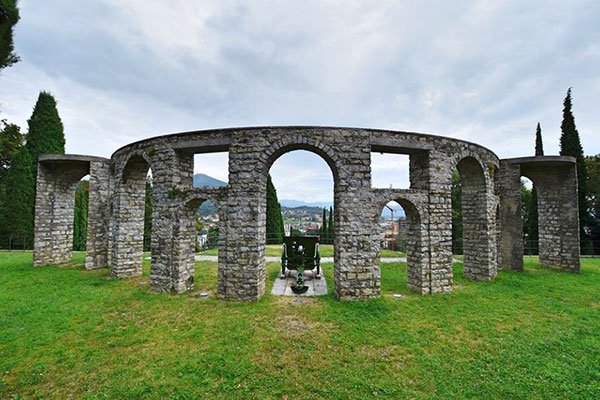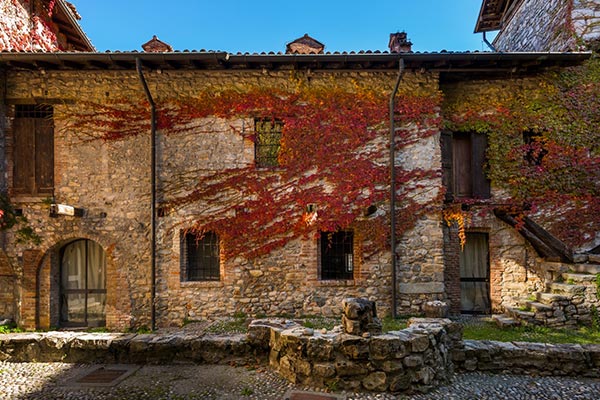is a municipality of about 16600 inhabitants in the Province of Como, in Lombardy.
Free Tour
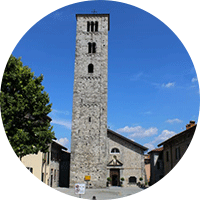
CHURCH OF SANT'EUFEMIA
CHURCH OF SANT'EUFEMIA
To the North of the face there is the Romanic bell tower of XII cent.. The nave has rectangular plant and has, on the right, a chapel that conserves a fresco of late ‘300, commissioned with specific decorative intent by the Parravicini’s and destined to adorn the San Bartolomeo altar.
The apse, one of the most ancient part of the church, is semi-circular; in the external part, it is divided by four lesenes, and also it has a decoration made by a typical horizontal angular bricks bands.
In the internal part, the most important work is a wood Cross painted in XVI cent. with the Christ image, in Giotto’s style, restored in 1983.
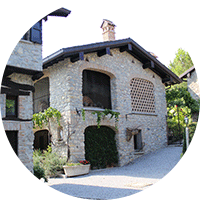
VILLINCINO
VILLINCINO
Between the 12th and 14th century, this was an active medieval centre, surrounded by stone walls and closed by gates at both ends.
One of the gates still presents an exquisite mullioned window.
At the end of the so-called contrada, indicating a district, you can find the pusterla, postern, and the house of the gabelliere, the medieval tax collector.
Nearby you can also admiring buildings dating from 12th century onwards.
Once you walk in this small village along the cobblestone road, you can appreciate old farmsteads and their typical stables or catch a glimpse of lovely private courtyards and blooming gardens beyond the doorways.
This village has been carefully restored and efforts have been made to give back the very same festive atmosphere characterizing this village in the Middle Ages.
Nowadays Villincino is a residential area. As there is neither traffic nor shops, after a few minutes it is like living in a time warp. As if you are most likely to encounter a dame with an elegant crown and a knight dressed in lively colours or to join the procession of a pagan feast, heading for the church of Sant’Eufemia(St. Euphemia) where everyone will be banqueting with polenta and wine.
However, you do not need to travel back in time to see such an event: on the third Sunday of October, the inhabitants of Erba join the feast of the Masigott, the greatest feast of the village.
In the square before the church of Sant’Eufemia, you can enjoy some polenta and other typical dishes. Besides, you cannot miss an event whose roots can be traced back in the past: the climbing of the greasy pole, which is a feat of strength for those who attempt to be the first to reach the top and grab the prize.
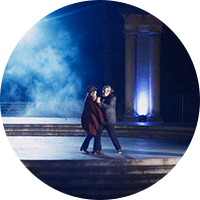
LICINIUM OPENAIR THEATRE
LICINIUM OPENAIR THEATRE
The echo of the old tradition has its peak with the visit of Licinium Theatre that, completely immersed in a natural context between trees and sky, it comes up as a classical theatre: it is an esedra with a monumental fixed stage, without borders and completely uncovered. To enrich the scene there is a simple classical arcade and the elegant semicircular staircase that bring you to the stage. A particularity of Licinium Theatre is the presence of a second grass stage behind the parterre, immersed in the green, with a suggestive stone staircase. The ancient aspect has a recent origin: Licinium Theatre is dated back to 1928, built for Airoldis’ will, who named it Licinium, a theatre of Greek inspiration, in honour to Roman consul Licinio, founder of the colony that gave origin to the town of Erba.
In less than a century, Licinium Theatre hosts several shows: from Euripides’ tragedies, to the great success “The Passion” , till the most caustic satire. Since the end of ‘60s, Licinium Theatre fell slowly into the oblivion, until 1993, with the foundation of Accademia dei Licini. The academy gave a new life to the theatre: the production was totally dedicated to Shakespeare’s operas.
As Orson Welles said: “Theatre resists like a divine anachronism”. There are not better words for Licinium Theatre. From the successes of the past, through bad periods, today it is the only one Italian open-air theatre. Licinium resists, giving to its public a magic and out of time atmosphere, between classical aspect, 20th century history and modern theatre.
HOW TO REACH ERBA
ASF Bus service
C 40 Como – Erba – Lecco
C 49 Como – Erba – Asso
By Train:
Trenord railway service from Milano Nord Cadorna, Regional Train R16 Asso – Seveso – Milano and stop in Erba
By Car:
From Como: get SS 342 in direction to Lecco
From Lecco: get SS 36 in direction to Milan and exit at Como/Erba
From Milan: get SS 36 in direction to Lecco and exit at Molteno/Merone. Continue on SP 41 in direction to Erba
Discover Green Lands
A Project by
Comune di Erba capofila, Comune di Albavilla, Comune di Albese con Cassano, Comune di Alserio,
Comune di Eupilio, Comune di Inverigo, Comune di Lambrugo, Comune di Lurago d’Erba,
Comune di Merone, Comune di Montorfano, Comune di Orsenigo, Comune di Ponte Lambro, Comune di Pusiano,
Sistema Turistico Lago di Como, Lariofiere Como Lecco, Confcommercio Como.
The project “Distretto dell’Attrattività Turistica Expo Green Land” is born thanks to the Regional DDG “Distretti dell’attrattività turistica e commerciale” 14 July 2014. Project n. 52574412.

